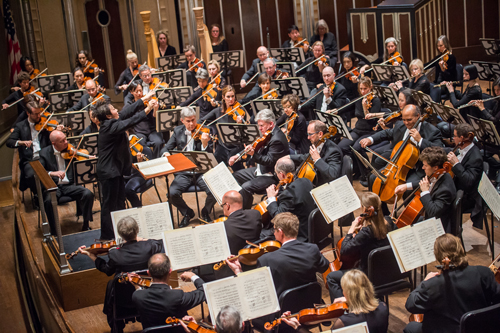by Daniel Hathaway

Katia and Marielle, the Labèque sisters, brought a brilliant reading of Mozart’s two-piano concerto to the first half of the program, while Xian Zhang, replacing Semyon Bychkov, took a pumped-up-on-steroids approach to Pyotr Tchaikovsky’s Manfred Symphony in the second half.
Probably inspired during his sojourn in Paris when concertante concertos involving multiple soloists were all the rage, Mozart’s duo-piano concerto comes down to us in two versions. He originally scored it for pairs of oboes, bassoons, horns, and strings in Salzburg, later adding clarinets, trumpets, and drums for use in Vienna. We heard the original scoring on Thursday evening.
Speculation has it that Mozart wrote the piece for himself and his sister Maria Anna, so it was fun to hear two siblings perform it in Cleveland. Playing from scores, the Labèques were evenly matched, but subtly different in their treatment of material that gets passed between the two performers. Mozart almost dares each of them to put their own spin on the music.
Though curiously short on the charm that inspires most of Mozart’s solo concertos, K. 365 gives its soloists an abundance of sparkling runs to execute, along with the mother of all trills just before the presto ending of the last movement.
The Labèques responded to a warm ovation with something completely different: the fourth of Philip Glass’s Four Movements for Two Pianos, a minimalist romp with a surprising caesura in the middle.

Xiang Zhang’s penchant for over-conducting was already evident in the Mozart but came into full flower during the Tchaikovsky symphony. She prodded each section of the Orchestra to generate outsized sonorities and dynamics, and whipped tuttis up to deafening levels on too many occasions. Sometimes added bulk was impressive — as in the astonishing string passage following the last-movement fugue — and the work ended in tragic glory when Joela Jones topped the Orchestra off with organ chorales at the end.
The Symphony is studded with unusual instrumental pairings and coloration. Hornist Michael Mayhew, bass clarinetist Yann Ghiro, and oboist Frank Rosenwein provided alluring moments with their splendid solos during the inner movements. But subtleties vanished in favor of sonic overload, and Zhang’s overwrought concept left many details undiscovered.
Photos by Ken Blaze courtesy of The Cleveland Orchestra.
Published on ClevelandClassical.com February 20, 2017.
Click here for a printable copy of this article



